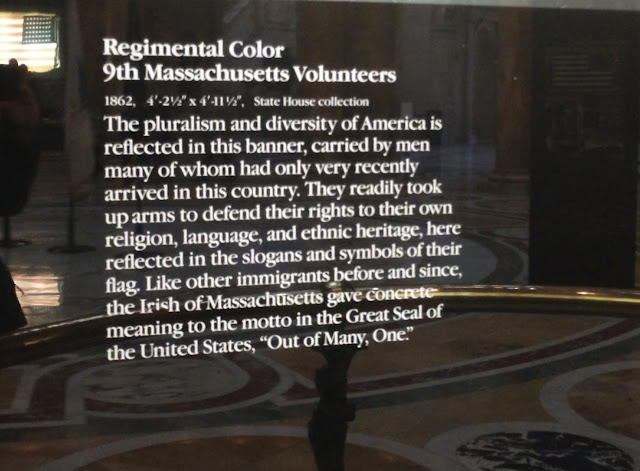In April 1861, Irish Volunteers from greater Boston Enlisted in the 9th Massachusetts Regiment to Help Preserve the Union
The Irish volunteers encamped on Long Island in Boston Harbor through May to train and organize. On June 11, 1861, the Ninth Massachusetts Regiment was mustered into service.
The 9th Regiment enjoyed an emotional send-off on June 25, 1861, when the troops made their way from Long Island to Long Wharf in Boston, then marched to Boston Common, where Governor John Andrew welcomed them and thanked the two commanders, Colonel Cass and Lieutenant Colonel Patrick Guiney.
Governor Andrew presented them with flags of the United States and the Commonwealth of Massachusetts, and the regiment was also permitted to carry its own Irish flag, which was donated by Mrs. Harrison Gray Otis.
The regiment fought bravely at many battlefronts during the Civil War, including Malvern Hill and Gettsburg. Colonel Cass was wounded at the Battle of Malvern Hill, and brought back to Boston, where he died a few weeks later. He was buried with military honors at Mount Auburn Cemetery in Cambridge.
The regiment returned to Boston on June 13, 1864 and was mustered out on June 21, 1864.
Nearly a century later, Massachusetts formed a Civil War Commission to mark the centennial of the Civil War and the Commonwealth's response to President Lincoln's appeal. In a Report issued on December 29, 1961, the Commission noted, "Colonel Cass had to get the permission of Governor Andrew to form the Irish regiment because a law passed some years before forbade men of foreign birth to fight for their adopted country."
See more about Art of the Civil War at the Massachusetts State House.
Today, the 9th Irish Flag at the Hall of Flags at the Massachusetts State House, along with the Thomas Cass statue on Boston's Public Garden, are part of Boston's Irish Heritage Trail. For year round information on Boston Irish history and heritage, visit IrishHeritageTrail.com
For year round details on Irish cultural events, visit IrishBoston.org.
Research + Text, Michael Quinlin







Comments
Post a Comment